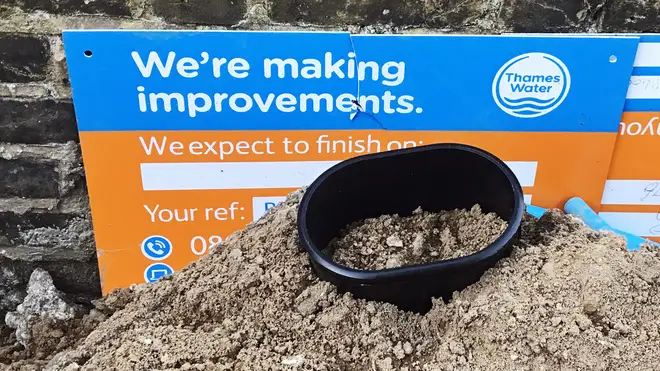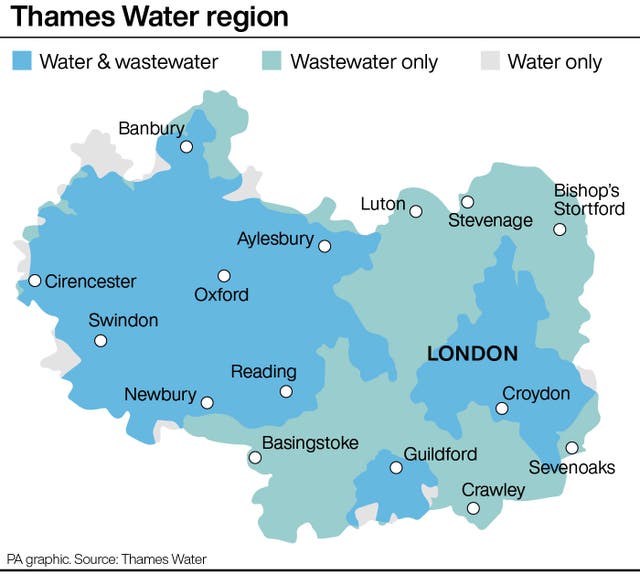
Tom Swarbrick 4pm - 6pm
29 June 2023, 15:14 | Updated: 14 July 2023, 09:17

Much of the debt was added when Thames Water was owned by Macquarie, the massive Australian investor.
The Government is on stand-by to step in should struggling utility Thames Water collapse.
As reports emerged this week that the company needs more money to survive, the PA news agency looks at the problems facing Thames Water and what the future may hold.
– Who actually owns Thames Water?
Through a series of holding companies, Thames Water is co-owned by a series of pension funds and foreign governments.
The biggest single shareholder is the Ontario Municipal Employees Retirement System, which holds around 32% of the shares. Another pension fund, the UK-based Universities Superannuation Scheme, holds another 20%.
Around 10% of the shares are owned by a subsidiary of the Abu Dhabi sovereign wealth fund, which is owned by the Abu Dhabi Government, and China’s sovereign wealth fund owns a little under 9%.
Other investors include the British Columbia Investment Management Corporation (8.7%), Hermes GPE (8.7%), Queensland Investment Corporation (5.4%), Aquila GP Inc (5%), and Stichting Pensioenfonds Zorg en Welzijn (2.2%).
– How much does Thames Water owe and how has its debt pile grown?
As of last September, Thames Water owed around £13.8 billion to its lenders, a figure that was around £840 million higher than six months earlier.
The company’s net debt has grown from just under £11 billion in 2018. Much of the debt was added when Thames Water was owned by Macquarie, the massive Australian investor.
In December 2005, before Macquarie bought the utility, Thames Water’s net debt was just £2.4 billion. When Macquarie sold it around a decade later, the debt pile had ballooned to more than £10 billion.
Thames Water had no debt when it was privatised by Margaret Thatcher in 1989.
– What interest does Thames Water pay on its debt?
Interest rates have been soaring over the last year for most people, and Thames Water is no different.

On average the interest that Thames Water paid on its debt was 6.63% in the year that ended in March 2022, compared to 4.55% in 2020.
As of last March, around £5.6 billion of Thames Water’s debt was at fixed interest rates, but around £7.7 billion of it was linked to retail price index inflation (RPI).
The company says that its loans are linked to inflation because the amount it charges customers also rises hand-in-hand with inflation. However customer bills are linked to the consumer prices index (CPI), not to RPI.
RPI has been much higher than CPI in recent times, putting extra pressure on the water company’s finances.
In May this year, RPI was at 11.3% while CPI was only 8.7%. RPI peaked at 14.2% in October last year.
– What could happen if the Government has to step in?
While most companies enter administration when they fail, some companies are considered too important to go bust.
Water and energy companies are among these because if they stop operating people could lose access to vital resources.
So for these companies the Government or regulator Ofwat can apply to a court to appoint a special administrator.
If called in, the special administrator would continue to run the company as usual, ensuring that water supplies to homes and businesses continue.
The administrator would also try to find another investor or private company to buy Thames Water and bring it out of administration.

The special administration regime (SAR) has only been used once before, when Bulb Energy collapsed in late 2021. Bulb was later bought by its former rival Octopus.
– Is my water supply in danger?
No. If you live in one of the 15 million households in London and the South East of England your water supply is not going to be interrupted no matter what happens to Thames Water.
In every scenario, the taps will keep running for Thames Water’s customers.
As Ofwat explained in 2015: “The purpose of the special administration regime is not to keep a company in business but rather to ensure that the provision of services to customers is maintained.”
– Are other water companies in a similar state?
There are other water companies that are in precarious financial positions, according to the water regulator.
In December, Ofwat flagged five firms which it said it was most worried about.
They were Thames Water, Portsmouth, Yorkshire, Southern and SES Water.
These companies all have higher-than-average gearing levels – which mean they have a higher proportion of debt compared to their equity.
However, Thames Water had the highest gearing level last year and the largest debt pile out of the five companies. Ofwat said it was monitoring and engaging with the five firms in a bid to strengthen their financial resilience.